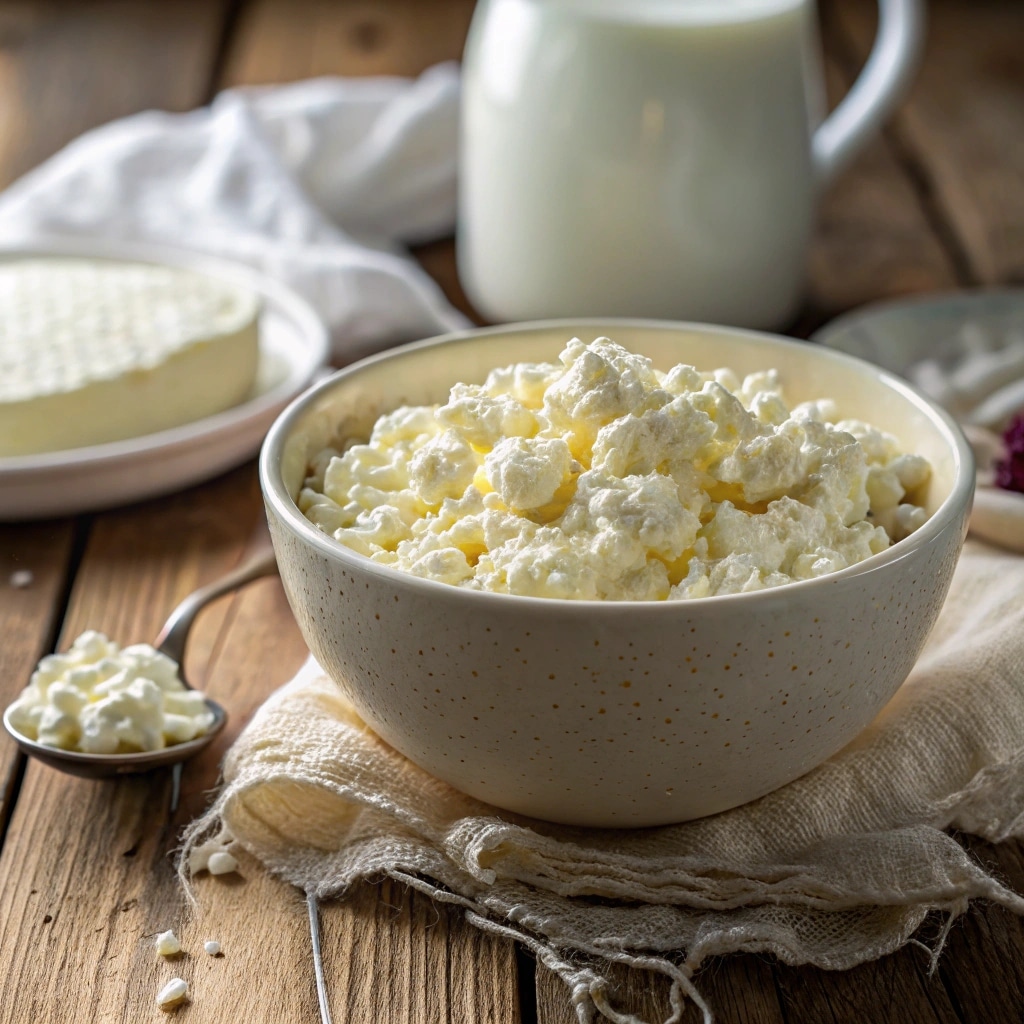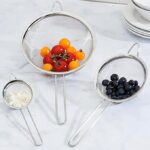Making homemade cottage cheese isn’t just a rewarding kitchen skill—it’s a healthier, more budget-friendly, and tastier alternative to store-bought options. Whether you’re a dairy enthusiast or simply curious about how to make cottage cheese from scratch, this guide will walk you through every step, from choosing the right ingredients to troubleshooting common issues. Along the way, you’ll learn about how cottage cheese is made, how to use it in your favorite recipes, and even discover some global cultural twists on this classic food.
Looking for inspiration? Try this guide on making homemade pistachio butter—another simple, rewarding kitchen staple.

Homemade Cottage Cheese
Equipment
Ingredients
- 1 gallon whole milk (not ultra-pasteurized)
- ½ cup white vinegar or lemon juice
- 1 tsp salt (optional)
- ¼ cup heavy cream (optional for creamier texture)
Instructions
- Pour the milk into a large, heavy-bottomed saucepan and heat slowly over medium heat until it reaches 120°F (49°C), stirring occasionally.
- Remove from heat and stir in vinegar or lemon juice. Let it sit undisturbed for 30 minutes until curds form and separate from whey.
- Line a fine mesh strainer with cheesecloth and place it over a bowl. Pour the mixture in to drain the whey from the curds.
- Rinse the curds under cold water while gently stirring to remove residual acidity.
- Transfer to a bowl. Add salt to taste and stir in heavy cream if using. Store in an airtight container in the fridge.
Notes
Nutrition
Table of Contents
Table of Contents
Understanding Homemade Cottage Cheese
What is Homemade Cottage Cheese?
Cottage cheese is a fresh, unripened cheese made by curdling milk with an acid like vinegar or lemon juice. Unlike hard cheeses that are aged and processed, cottage cheese is soft, moist, and ready in under an hour. It’s known for its slightly tangy flavor and creamy texture dotted with small curds.
When you make cottage cheese at home, you get full control over its consistency, fat level, and taste. It’s perfect for those who want to avoid additives or simply enjoy food that’s made from scratch. You can enjoy it on its own, add it to savory meals, or blend it into sweet dishes for extra protein.
Homemade versions often use simple ingredients: whole milk, an acid (like lemon juice or vinegar), and salt. This minimal approach means you can avoid preservatives and tailor your batch to your preferences.
How Cottage Cheese is Made: Traditional and Modern Methods
At its core, cottage cheese is made by separating milk into curds (solids) and whey (liquid). This process, known as milk coagulation, is typically achieved by heating milk and then introducing an acidic agent to encourage curd formation.
Traditional Method
Traditionally, raw or fresh milk is left to sour naturally at room temperature. Over time, the milk ferments and naturally separates. This slow fermentation results in soft, small curds with rich flavor. However, this method requires patience and close monitoring to avoid spoilage.
Modern Homemade Method
The modern method, perfect for home kitchens, involves gently heating milk and then curdling it with vinegar or lemon juice. This method gives you quicker results and more control. The curds are then drained, rinsed, and optionally salted.
Here’s a basic flow of the modern cottage cheese-making process:
- Heat whole milk slowly until it reaches 120°F (49°C).
- Stir in lemon juice or white vinegar.
- Let the milk curdle and rest.
- Drain the curds in a cheesecloth.
- Rinse with cold water and season to taste.
By understanding the science and techniques behind it, you’ll appreciate not just how it’s made but also how simple and satisfying it is to make at home.
Ingredients and Tools You’ll Need
The Main Ingredient in Cottage Cheese
If you’re wondering, “What is the main ingredient in cottage cheese?”—the answer is simple: milk. To make homemade cottage cheese, you need fresh, high-quality milk. The type of milk you choose will greatly impact the flavor, texture, and creaminess of the final product.
Here’s a quick comparison table:
| Type of Milk | Result in Cottage Cheese |
|---|---|
| Whole Milk | Creamy, rich texture |
| 2% or Low-Fat Milk | Less creamy, slightly firmer curds |
| Raw Milk | Traditional taste, rich in natural bacteria |
| Non-Dairy Milk (with mods) | Not ideal; needs added coagulation agents |
If you’re following a traditional or old-fashioned method, raw milk is often used to give a more complex flavor. However, for most home cooks in the U.S., pasteurized whole milk works just fine.
For a twist, some people also use goat milk or A2 milk to make homemade cottage cheese more digestible. The key is to avoid ultra-pasteurized or UHT milk, which doesn’t curdle well.
Also, the acidifier (coagulant) is essential. You can use:
- White vinegar
- Fresh lemon juice
- Citric acid powder
- Yogurt (in some variations)
That leads to another common question: Can I use yogurt to make cottage cheese?
Yes, you can. Yogurt can be used as a natural acid source for curdling milk. It adds a mild tanginess and a boost of probiotics, which is ideal if you’re aiming for a gut-friendly version of homemade cottage cheese. Just ensure it’s plain, unsweetened yogurt with live cultures.
Tools Required for Making Cottage Cheese at Home
You don’t need fancy equipment to make homemade cottage cheese. Here’s what you’ll want on hand:
| Tool | Purpose |
|---|---|
| Heavy-bottom saucepan | Evenly heats milk without scorching |
| Food thermometer | Ensures precise curdling temperatures (110–120°F) |
| Cheesecloth or muslin | Strains out the whey to leave only curds |
| Fine mesh strainer | Helps drain curds more easily |
| Slotted spoon | Gently scoops curds without breaking them |
| Mixing bowl | Catches the drained whey |
Using these tools helps streamline the process. Most home kitchens already have these items, making the entire journey to how to make cottage cheese at home totally approachable.
Discover great ideas like using chia seeds in yogurt to complement your homemade dairy creations for breakfast.
How to Make Homemade Cottage Cheese From Scratch
Step-by-Step Guide: How Do You Make Homemade Cottage Cheese?
If you’ve ever asked yourself, “How do you make cottage cheese?”, the answer is simpler than you think. Making homemade cottage cheese requires just a few ingredients, basic tools, and less than an hour of your time. This step-by-step guide walks you through the entire process so you can create a fresh, wholesome, preservative-free batch right in your own kitchen.
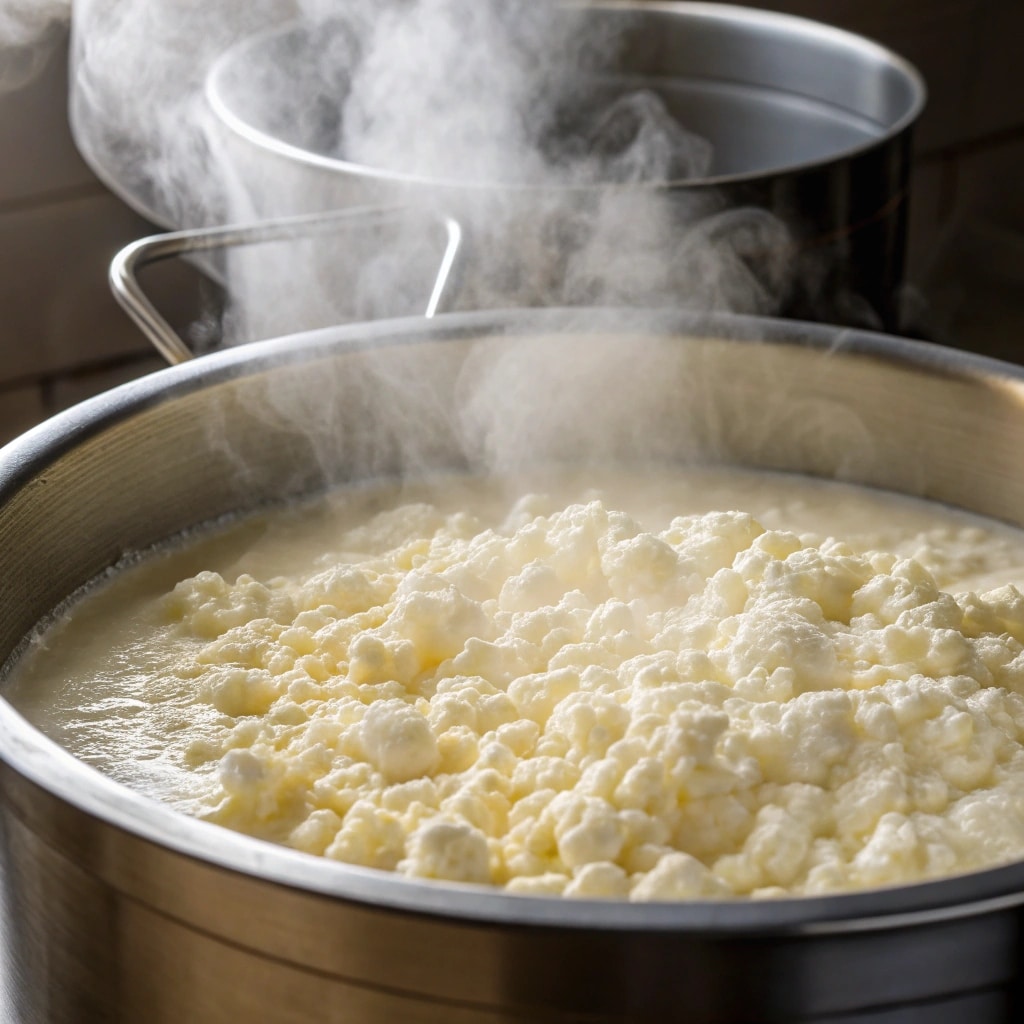
Here’s the easiest and most reliable recipe for homemade cottage cheese using whole milk and vinegar.
Ingredients:
- 1 gallon whole milk (avoid ultra-pasteurized)
- 1/2 cup white vinegar or lemon juice
- 1 teaspoon salt (optional)
- 1/4 cup heavy cream (optional for creamy curds)
Instructions:
- Heat the Milk
Start by pouring the milk into a large, heavy-bottomed pot. Slowly warm it over medium heat until it reaches 120°F (49°C). Stir occasionally to keep it from burning. This step is crucial in helping your homemade cottage cheese curdle properly. - Add Acid to Form the Curds
Remove the milk from heat and gently stir in the vinegar or lemon juice. You’ll notice the milk starts to separate into curds and whey. Let it rest for 30 minutes while the magic happens. This is where how cottage cheese is made truly begins. - Strain and Drain
Place a cheesecloth or clean muslin cloth inside a strainer, then pour the curdled mixture into it. Let the whey drain away completely. Rinse the curds under cold water while stirring gently. This helps cool the cheese and remove any sourness from the vinegar or lemon. - Season and Cream
Transfer your fresh homemade cottage cheese to a bowl. Add salt to taste and stir in cream if you like it rich and velvety. Your cottage cheese is now ready to serve!
Want to spice it up? Don’t miss our honey peach cream cheese cupcakes that pair beautifully with fresh, tangy cottage cheese fillings.
Whether you use it for snacking, baking, or topping toast, this recipe for homemade cottage cheese proves you don’t need processed store-bought options to enjoy delicious, fresh dairy.
How to Make Homemade Cottage Cheese from Raw Milk
For a more traditional and nutrient-dense version, you can also learn how to make homemade cottage cheese from raw milk. This method preserves more enzymes and beneficial bacteria for those seeking a natural, farm-to-table approach.
Why Use Raw Milk for Homemade Cottage Cheese?
Raw milk brings a deeper, richer flavor to homemade cottage cheese and reflects the way it was originally made in kitchens around the world. It’s unprocessed, full of natural cultures, and perfect for fermentation.
How to Do It Safely:
- Source high-quality raw milk from a reliable local farm.
- Sanitize all tools and containers.
- Allow the milk to sour at room temperature for 24–36 hours.
- Once naturally curdled, warm the milk gently to around 110°F.
- Pour through cheesecloth to separate curds from whey.
- Rinse the curds under cold water, then salt and cream to taste.
That’s how you create rich, tangy, authentic homemade cottage cheese from raw milk—a timeless technique loved by real food lovers.
Looking for a healthy, dairy-based breakfast idea? Discover our lemon chia pudding with yogurt for another gut-friendly creation.
Variations and Substitutions
Can I Use Yogurt to Make Homemade Cottage Cheese?
Yes, you absolutely can! In fact, using yogurt is one of the gentlest ways to create homemade cottage cheese that’s loaded with natural probiotics. Many people looking for a smoother, less tangy taste often ask, “Can I use yogurt to make cottage cheese?”—and the answer is not only yes, but it can also enhance both taste and texture.
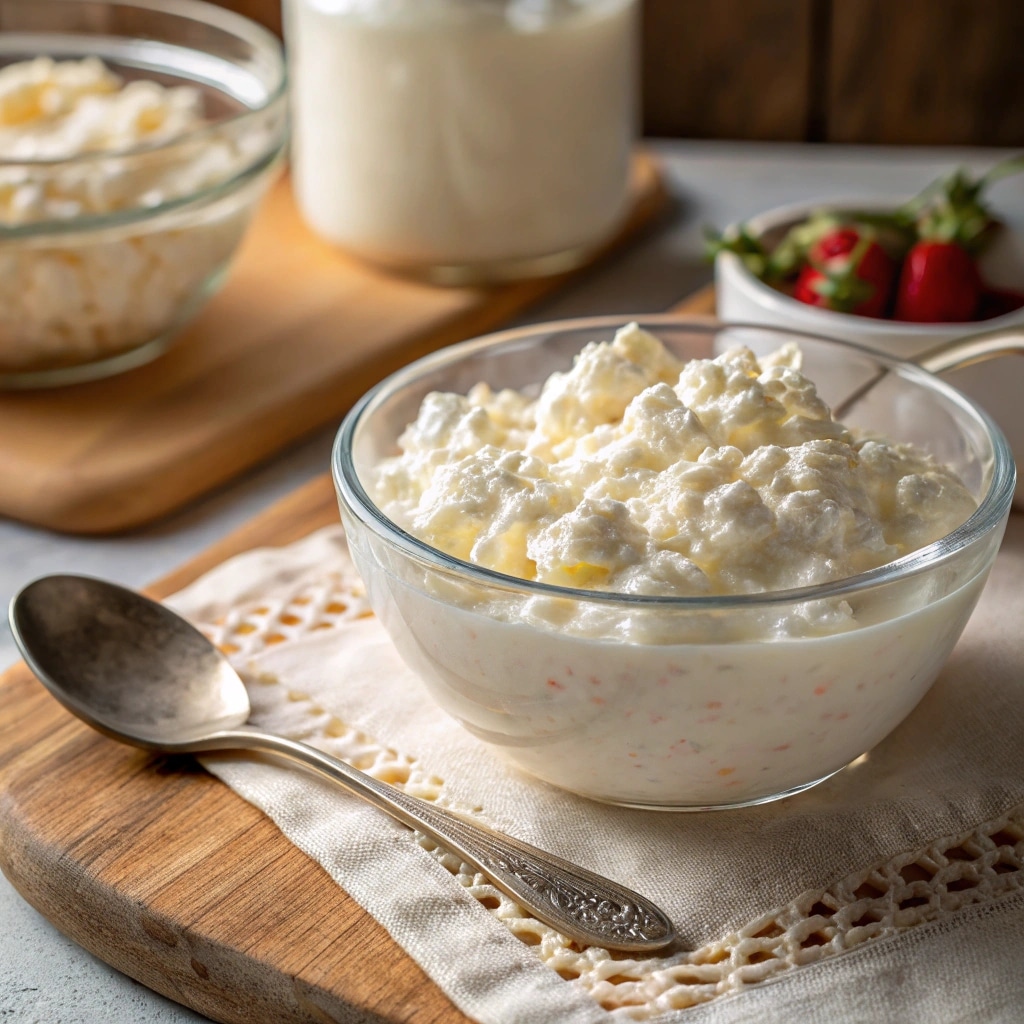
Here’s how to do it:
Yogurt-Based Homemade Cottage Cheese Recipe
- Warm 1 gallon of whole milk to around 110°F.
- Stir in 1/2 cup of plain, full-fat yogurt with live cultures.
- Let the mixture rest in a warm space for 6 to 8 hours.
- Once curds form, gently heat to 120°F to help the whey separate.
- Strain through a cheesecloth, rinse with cold water, and enjoy.
This version has a softer, creamier consistency and a mild, fresh taste. It’s especially popular for those who prefer lighter flavors in their dairy dishes.
Check out fresh summer salad ideas to pair beautifully with your tangy yogurt-based cottage cheese.
Yogurt acts as a natural starter in this process, replacing vinegar or lemon juice. Plus, it’s more forgiving for first-time makers who are nervous about curdling milk with acids.
Homemade Cottage Cheese for Special Diets
Homemade cottage cheese can be adapted for various dietary needs. Whether you’re avoiding lactose, looking for plant-based alternatives, or simply want a lighter version, there are several ways to tweak the traditional method.
Vegan and Dairy-Free Options
Though true cottage cheese requires dairy, some substitutes offer a similar texture using plant-based ingredients:
- Tofu-based cheese: Blend silken tofu with lemon juice and salt, then refrigerate.
- Cashew curd: Soak cashews, blend until smooth, add probiotics or lemon juice, and let ferment for 12–24 hours.
- Almond milk cheese: Use thick, unsweetened almond milk with agar agar or lemon juice to mimic curd texture.
While these aren’t technically homemade cottage cheese, they’re excellent substitutes for vegans or those with lactose intolerance.
Low-Fat and Protein-Packed Versions
To reduce fat but maintain protein, use 2% or skim milk and strain for longer to firm up the curds. You can also add Greek yogurt for creaminess and a probiotic boost.
Don’t miss our guide on quinoa recipes—another high-protein addition that pairs perfectly with a scoop of homemade cottage cheese.
Storing and Using Homemade Cottage Cheese
Best Ways to Store Homemade Cottage Cheese
Once you’ve prepared a batch of fresh homemade cottage cheese, storing it properly is essential to maintain its flavor and safety. Since this cheese doesn’t contain preservatives, it’s best consumed fresh—but there are smart ways to extend its usability.
Storage Guidelines:
- Use an airtight container: Always transfer your cottage cheese to a clean, airtight glass or BPA-free plastic container.
- Keep it refrigerated: Store your homemade cottage cheese at or below 40°F (4°C) in the coldest part of your fridge.
- Avoid cross-contamination: Use a clean spoon each time to avoid introducing bacteria.
Shelf Life:
| Storage Type | Shelf Life |
|---|---|
| In fridge (airtight) | 4–5 days |
| In freezer (optional)* | Up to 2 months (texture may change) |
*Note: While freezing is possible, it may slightly alter the curd structure, making it crumblier when thawed. It’s still safe to eat and ideal for baked recipes.
Looking for inspiration? Try adding it to air fryer lemon chicken bites for a protein-rich topping or side.
To maximize shelf life, consider dividing your batch into smaller portions to avoid repeated exposure to air and bacteria.
How Long Does Homemade Cottage Cheese Last in the Fridge?
This is one of the most common questions: “How long does homemade cottage cheese last?” The answer depends on how well it’s stored. Under optimal conditions, fresh homemade cottage cheese stays good for up to 5 days. Beyond that, the risk of spoilage increases.
Signs Your Cottage Cheese Has Gone Bad:
- Sour, off-putting smell
- Yellowing or discoloration
- Slimy texture
- Mold growth
If you notice any of these signs, it’s best to discard the cheese. Remember, homemade cottage cheese is perishable—its lack of preservatives makes it more natural, but also more sensitive.
Don’t miss our samosa pizza chaat for a spicy, creative way to use leftover cottage cheese curds as a fusion topping.
To make your cheese last a little longer, stir in a pinch of salt and cover the top with a thin layer of cream before sealing the container. The salt inhibits bacteria, and the cream layer keeps moisture in.
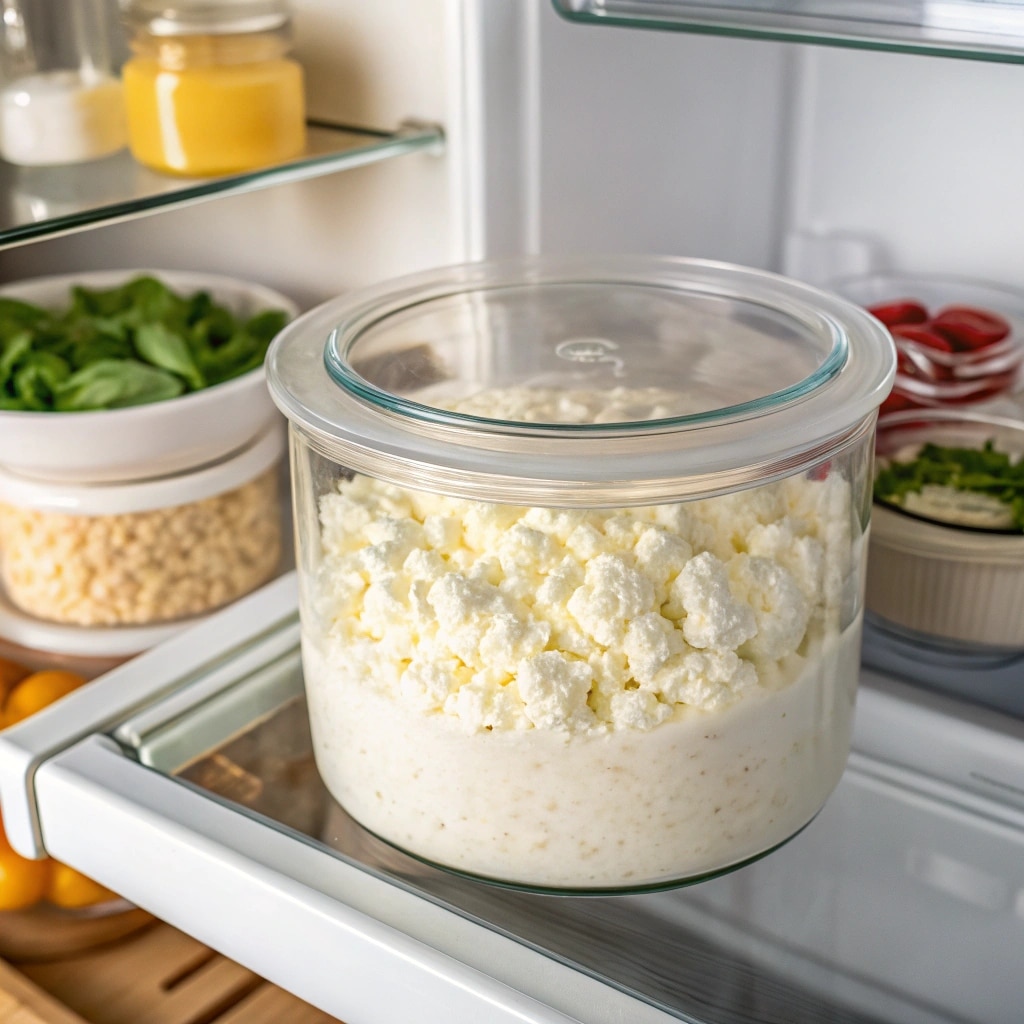
Frequently Asked Questions About Homemade Cottage Cheese
How do I make cottage cheese from scratch?
To make homemade cottage cheese from scratch, heat whole milk to around 120°F, then stir in an acid like white vinegar or lemon juice. Once the curds separate from the whey, strain the mixture through cheesecloth, rinse with cold water, and salt to taste. This creates soft, fresh, preservative-free cottage cheese in less than an hour.
What is cottage cheese in Arabic?
In Arabic, cottage cheese is commonly referred to as “جبنة قريش” (Jubnat Qareesh). It’s widely enjoyed across Middle Eastern cuisines in dishes like salads, dips, and pastries, often paired with herbs or olive oil.
Can I use yogurt to make cottage cheese?
Yes! Yogurt can be used instead of vinegar or lemon juice to create a probiotic-rich version of homemade cottage cheese. Warm the milk, stir in plain yogurt with live cultures, and allow it to ferment for 6–8 hours before straining the curds. This method creates a creamier, tangier batch.
What is the main ingredient in cottage cheese?
The main ingredient in homemade cottage cheese is milk—preferably whole milk or raw milk for the best results. Milk provides the protein and fat needed to form curds when combined with an acid, which is what gives cottage cheese its signature texture and taste.
Conclusion: Why Homemade Cottage Cheese Is Worth Making
Making homemade cottage cheese may seem old-fashioned, but it’s one of the easiest and most rewarding kitchen projects you can try. Not only do you control the ingredients and flavor, but you also avoid preservatives and save money in the long run. Whether you’re curious about how to make cottage cheese, trying to replicate your favorite recipe for cottage cheese, or just love exploring traditional foods, this guide gives you everything you need to succeed.
With just milk, an acid, and a few kitchen tools, you can make fresh homemade cottage cheese that tastes better than anything store-bought. It’s versatile, nutritious, and can be used in everything from savory meals to breakfast bowls.
Don’t miss our guide on Italian pizza sauce recipe for a savory pairing, or prune juice and butter recipes for unique dairy-based hacks that complement cottage cheese textures.
If you haven’t tried it yet, now’s the perfect time to grab a pot and make your first batch of homemade cottage cheese—it’s easier than you think and way more satisfying.
for more recipes follow us in Pinterest

